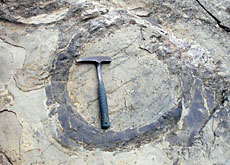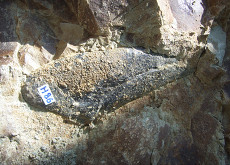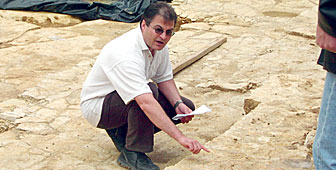World’s oldest Sauropod footprints uncovered

An amateur palaeontologist has stumbled upon fossilised dinosaur footprints of a member of the Sauropod family that experts say are at least 200 million years old.
The find on a rocky, almost vertical mountainside in the southeastern Swiss Alps, is also much older than the similar track discoveries in the Jura mountain range in the west of the country.
The Sauropod footprints were first spotted a year ago on Tinzenhorn mountain in the Ela nature park by the schoolteacher and amateur palaeontologist, Rico Stecher. Swiss scientists confirmed the find at a news conference in Chur on Wednesday.
It was Stecher’s second spectacular discovery. Earlier this year in the same area, he uncovered the best-preserved pterodactyl fossil in Switzerland.
A dinosaur expert from Basel’s natural history museum, Christian Meyer, said the Sauropod prints from the Triassic period are circular in shape and have a circumference of 60 centimetres.
The dinosaur was a long-necked and long-tailed herbivore about six metres long and a few metres tall.
Meyer said there was still a lot to learn about the prints and his team had just begun its investigation but the fossils were significant for other reasons than just their age.
The palaeontologist said it was the first time such a discovery was made in this particular type of geological formation. The area is believed to have been covered by a sea before the formation of the Alps and must have experienced a period when it was dry land.
Second find
Other fossilised dinosaur prints found around the same time on the neighbouring mountain, Piz Mitgel, were presented as well.
A team of climbers spotted a steep mountain face saturated with the ancient footprints during their descent from the peak. Some of them were also made by Sauropods but the scientists have not deciphered the rest.
There has been a rich harvest of dinosaur fossils this year in Switzerland. A fossil collector found the bones of two Plateosaurus in Frick in northern Switzerland in May, unearthing what may turn out to be Europe’s largest dinosaur graveyard.
Since 2002, thousands of footprints have been excavated in the Jura mountains. Swiss scientists believe the area is one of the most important dinosaur track sites in the world.
swissinfo with agencies
Dinosaurs dominated the earth for over 160 million years, first appearing 230 million years ago. They died out 65 million years ago.
The first dinosaur fossil to be discovered in mainland Europe was of a Plateosaurus or “flat lizard”, which was found in southern Germany in 1837.
Plateosaurus is one of the most common dinosaur fossils discovered on the continent in over 50 locations.
The plant-eating Plateosaurus lived around 216 to 199 million years ago. It was the first really big dinosaur – up to ten metres long and four metres high.
Plateosaurus were bulky bipedal herbivores, which had a small skull on a long neck, sharp teeth, long tail, powerful limbs, and a large thumb spike on each “hand” probably used for defence and feeding.

In compliance with the JTI standards
More: SWI swissinfo.ch certified by the Journalism Trust Initiative











You can find an overview of ongoing debates with our journalists here . Please join us!
If you want to start a conversation about a topic raised in this article or want to report factual errors, email us at english@swissinfo.ch.